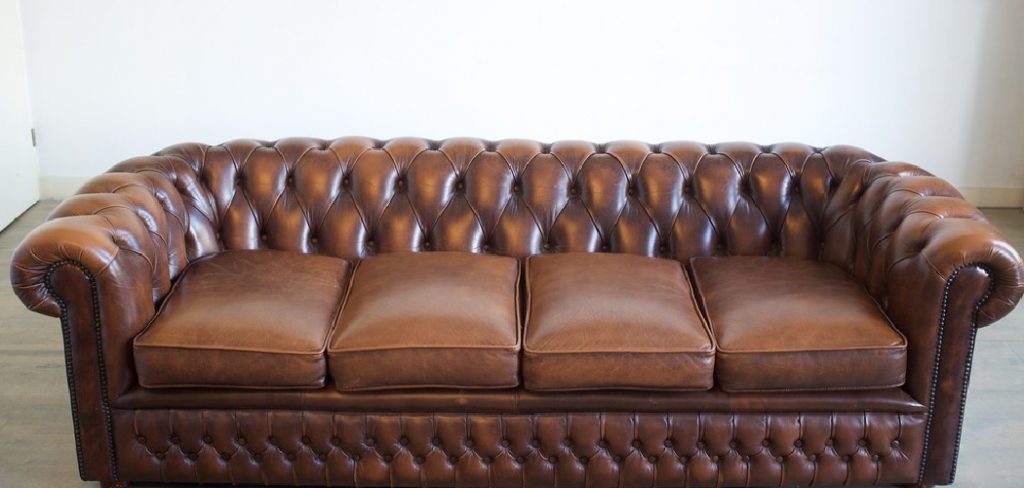Repainting a leather sofa can breathe new life into worn or outdated furniture, allowing you to customize its look to suit your style and decor. Whether you’re looking to refresh the color, cover up stains, or simply update the aesthetic of your sofa, repainting is a cost-effective and relatively simple solution. In this article, we’ll explore the step-by-step process of how to repaint a leather sofa, from preparing the surface and choosing the right paint to applying multiple coats and sealing the finish.

With the right materials, techniques, and attention to detail, you can achieve professional-looking results and transform your leather sofa into a focal point of your living space. Whether you’re a DIY enthusiast or a novice painter, repainting a leather sofa is a rewarding project that can revitalize your furniture and enhance the overall ambiance of your home.
Importance of Proper Preparation and Techniques
The success of repainting a leather sofa largely hinges on proper preparation and the use of correct techniques. Before initiating the painting process, it’s essential to thoroughly clean the sofa, removing dirt, oils, and any pre-existing coatings that may impede paint adhesion. This step ensures the paint adheres properly to the leather, preventing peeling or cracking over time.
Equally important is the selection of the right type of paint specifically formulated for leather, which can flex and move without cracking. Techniques such as applying thin, even coats and allowing sufficient drying time between layers can dramatically affect the durability and appearance of the finish.
Skipping these preparatory steps or rushing through the process can result in unsatisfactory outcomes, making the effort and resources invested in the project futile. Therefore, proper preparation and adherence to best practices are indispensable for achieving a seamless, long-lasting finish that revives your leather sofa.
The Appeal of Repainting Leather Sofas
Repainting leather sofas has become increasingly popular for several reasons. Firstly, it offers homeowners an affordable way to update their furniture without the need for costly replacements or professional reupholstering services. This Do-It-Yourself approach not only saves money but also allows for a high degree of customization, enabling individuals to choose colors and finishes that perfectly match their home decor and personal style.
Furthermore, repainting can extend the life of a sofa, making it an eco-friendly option that contributes to waste reduction by giving old furniture a new lease on life instead of discarding it. This practice aligns with the growing trend towards sustainability and environmentally conscious living. Thus, the appeal of repainting leather sofas lies in its cost-effectiveness, personalization possibilities, and environmental benefits, making it an attractive option for those looking to refresh their living spaces.
Understanding Leather Properties
Understanding the unique properties of leather is crucial before undertaking a repainting project. As a natural material, leather varies widely in its texture, porosity, and flexibility. These characteristics can significantly impact how paint adheres and behaves on the surface. For instance, highly porous leather may absorb paint more readily, which can affect the amount of paint required and the uniformity of the finish. On the other hand, leather with a smoother, less porous surface may require specific preparation techniques to ensure the paint bonds effectively.

Additionally, the flexibility inherent to leather necessitates the use of paints that can stretch and move without cracking or peeling, preserving the natural feel and comfort of the sofa. Acknowledging and adapting to these properties are essential steps in achieving a successful repainting outcome that both looks beautiful and withstands the test of time.
Types of Leather Finishes
When planning to repaint a leather sofa, it’s important to understand the various types of leather finishes, as this will influence both the choice of paint and the preparation process. Leather finishes can be broadly categorized into three types: aniline, semi-aniline, and pigmented (protected) leather.
Aniline leather is the most natural-looking type of leather, treated with soluble dyes that do not obscure the hide’s natural markings or grain. This finish offers a soft, warm feel but is less resistant to staining and fading, making it somewhat more challenging to repaint.

Semi-aniline leather is slightly more durable than aniline, having a thin protective coat that offers better resistance to staining and wearing while still maintaining the leather’s natural appearance. Repainting semi-aniline leather requires careful preparation to ensure that the new paint adheres well without compromising the leather’s texture and feel.
Pigmented (Protected) leather is the most durable type of finish, characterized by a polymer surface coating that contains pigments. This type of leather is easier to repaint as the surface is more uniform and resistant to absorption. However, achieving a smooth finish requires that the paint is compatible with the polymer coating to avoid reactions that can lead to cracking or peeling.
Choosing the Right Paint and Color
Selecting the appropriate paint and color for your leather sofa is pivotal to achieving an appealing and long-lasting finish. For leather, specially formulated acrylic or leather paints are recommended because of their flexibility and durability. These paints are designed to bond with leather surfaces without cracking or peeling over time, making them ideal for furniture that undergoes regular use.
When choosing a color, consider the existing decor of your room to ensure that your repainted sofa complements the overall design theme. Opting for classic colors such as black, brown, or white can offer versatility, while bold colors can make a statement and breathe new life into the space.
10 Methods How to Repaint a Leather Sofa
Method 1: Prepare the Leather Surface
Before repainting your leather sofa, it’s essential to thoroughly clean and prepare the surface to ensure proper adhesion of the paint. Begin by wiping down the entire sofa with a damp cloth to remove any dirt, dust, or surface grime. For stubborn stains, use a mild leather cleaner or saddle soap to gently scrub the area. Allow the leather to dry completely before proceeding to the next step.

Next, lightly sand the surface of the sofa with fine-grit sandpaper to roughen up the leather. This step will help the paint adhere better and prevent it from peeling or cracking later on. Be sure to work in small sections and use a light touch to avoid damaging the leather. Once finished, wipe down the sofa again with a damp cloth to remove any sanding residue.
Method 2: Sand the Leather
To promote better paint adhesion and smooth out any rough patches or imperfections, lightly sand the leather surface with fine-grit sandpaper. Be gentle and use a circular motion to avoid damaging the leather. Focus on areas with heavy wear or scratches, as well as any glossy or shiny spots that may hinder paint adhesion. After sanding, wipe away any dust with a clean, damp cloth.

Sanding the leather can also help to remove any old paint or finishes that may be present on the surface. This will create a clean and even base for your new paint job. Additionally, sanding can help to open up the pores of the leather, allowing the paint to better penetrate and adhere to the surface.
Method 3: Choose the Right Paint
Selecting the right paint is crucial for achieving a professional-looking finish on your leather sofa. Opt for a high-quality leather paint specifically formulated for use on leather surfaces. Leather paints come in a variety of colors and finishes, including matte, satin, and glossy. Choose a color that complements your existing decor and personal style. Additionally, consider using a primer designed for use on leather to ensure better adhesion and durability of the paint.
You may also want to look for a paint that has added ingredients such as UV protection or water resistance, especially if your sofa will be exposed to sunlight or potential spills. This can help prolong the life of your painted leather sofa and prevent any fading or damage.
Method 4: Test the Paint
Before applying the paint to the entire sofa, it’s important to test it on a small, inconspicuous area to ensure compatibility and desired results. Apply a small amount of paint to an inconspicuous spot on the sofa and allow it to dry completely. Assess the color, coverage, and finish to determine if it meets your expectations. If satisfied, proceed with painting the rest of the sofa. If not satisfied, try a different type or brand of paint or consider alternative methods for sprucing up your sofa.
Testing the paint on a small area also allows you to make any necessary adjustments before committing to painting the entire sofa. For example, if the color appears too dark, you can dilute the paint with water to achieve a lighter shade. Or if the coverage is not even, you can apply multiple thin coats instead of one thick coat. Additionally, testing the paint on a small area will give you an idea of how many coats may be needed for full coverage.

Method 5: Apply Thin Coats of Paint
When applying paint to your leather sofa, it’s best to work in thin, even coats to achieve a smooth and consistent finish. Use a high-quality paintbrush or sponge applicator to apply the paint, working in small sections at a time. Avoid applying too much paint at once, as this can lead to drips, streaks, or uneven coverage. Allow each coat to dry completely before applying the next one, following the manufacturer’s recommended drying times. This will help prevent the paint from cracking or peeling over time.
To ensure even coverage, it’s important to apply thin coats of paint. This may require several coats to achieve the desired color and finish. Don’t be discouraged if the first coat doesn’t look perfect – multiple coats will help build up a more solid layer of paint and create a smoother surface. It’s also important to remember that leather is a porous material, so the paint may look slightly different once it has fully dried.
Method 6: Allow Sufficient Drying Time
Proper drying time is essential for achieving a durable and long-lasting finish on your repainted leather sofa. Allow each coat of paint to dry completely before applying additional coats or handling the sofa. Depending on the type of paint and environmental conditions, drying times may vary. Follow the manufacturer’s instructions for recommended drying times between coats, and avoid rushing the process to ensure the best results.
In addition to allowing sufficient drying time between coats, it is also important to properly cure the paint before using the sofa again. This typically takes anywhere from 24-48 hours, but can vary depending on the type of paint used and environmental factors. Avoid placing any objects or sitting on the sofa during this curing period to prevent smudging or damaging the paint finish.
Method 7: Seal the Paint
To protect the painted surface and enhance its durability, consider applying a clear sealant or topcoat specifically designed for use on leather. The sealant will help protect the paint from scratches, stains, and fading, extending the life of your repainted sofa. Apply the sealant in thin, even coats using a clean brush or sponge applicator, and allow it to dry completely between coats. Follow the manufacturer’s instructions for application and drying times. Once the sealant is dry, buff the surface lightly with a soft cloth to remove any excess residue and create a smooth finish.
Sealing the paint also provides added protection from spills and moisture, making it easier to clean and maintain your repainted leather sofa. However, keep in mind that some sealants may change the appearance of the painted surface. It’s always best to do a test patch on an inconspicuous area before applying it to the entire sofa.

Method 8: Buff and Polish
After the final coat of paint has dried and the sealant has cured, gently buff the painted surface with a soft, lint-free cloth to smooth out any imperfections and enhance the shine. Use a circular motion to buff the entire sofa, taking care not to apply too much pressure. For an added layer of protection and shine, consider applying a leather conditioner or polish to nourish the leather and maintain its suppleness. This method is great for maintaining the longevity of your leather sofa and keeping it looking like new.
In addition to buffing, you can also use a polishing technique to give your leather sofa an extra shine. Use a clean cloth and apply a small amount of leather polish or wax onto the surface. Gently rub the polish in using circular motions, making sure to cover all areas evenly. Allow the polish to dry completely before lightly buffing it with a soft cloth for a high-gloss finish.
Method 9: Touch Up as Needed
Once the paint and sealant have dried completely, inspect the repainted sofa for any areas that may need touching up or additional coats of paint. Use a fine-tip brush or sponge applicator to carefully touch up any missed spots or areas with uneven coverage. Allow the touch-up paint to dry completely before assessing the results and determining if additional touch-ups are necessary.
Touching up the paint may also involve blending in any brush marks or visible lines between coats. This can be achieved by lightly sanding the surface with fine-grit sandpaper and gently buffing the area with a clean cloth. Additionally, using a clear sealant or topcoat can help to smooth out any uneven areas and give the repainted sofa a professional finish.

Method 10: Maintain and Protect
To keep your repainted leather sofa looking its best for years to come, practice regular maintenance and protection. Clean the sofa regularly with a mild leather cleaner or soap and water to remove dirt and debris. Avoid using harsh chemicals or abrasive cleaners that may damage the painted surface. Additionally, consider applying a leather conditioner or protectant periodically to nourish the leather and maintain its color and suppleness.
Aside from regular cleaning and conditioning, there are other ways to protect your repainted leather sofa. First, avoid placing it in direct sunlight or near heat sources, as this can cause the paint to fade or crack. If possible, position the sofa away from windows or invest in blinds or curtains to block out UV rays. Second, be mindful of sharp objects that may scratch or puncture the leather, such as pet nails or jewelry. Use protective covers or blankets when sitting on the sofa to prevent accidental damage.
Conclusion
In conclusion, repainting a leather sofa can be a transformative process that breathes new life into worn or outdated furniture. By following the outlined steps and taking care to prepare the leather surface properly, individuals can achieve impressive results that restore the sofa’s appearance and prolong its lifespan.
Selecting the right paint and color, applying multiple coats evenly, and sealing the surface ensure a durable and professional-looking finish. Regular maintenance and touch-ups help preserve the repainted surface and maintain its beauty over time. Thanks for reading, and we hope this has given you some inspiration on how to repaint a leather sofa!
Huston Douthit is a distinguished figure in the world of furniture design, with a decade of expertise creating innovative and sustainable furniture solutions. His professional focus lies in merging traditional craftsmanship with modern manufacturing techniques, fostering designs that are both practical and environmentally conscious. As the author of Fruniturix, Huston delves into the art and science of furniture-making, inspiring artisans and industry professionals alike.
Education
- RMIT University (Melbourne, Australia)
Associate Degree in Design (Furniture)- Focus on sustainable design, industry-driven projects, and practical craftsmanship.
- Gained hands-on experience with traditional and digital manufacturing tools, such as CAD and CNC software.
- Nottingham Trent University (United Kingdom)
Bachelor’s in Furniture and Product Design (Honors)- Specialized in product design with a focus on blending creativity with production techniques.
- Participated in industry projects, working with companies like John Lewis and Vitsoe to gain real-world insights.
Publications and Impact
In Fruniturix, Huston shares his insights on furniture design processes, materials, and strategies for efficient production. His writing bridges the gap between artisan knowledge and modern industry needs, making it a must-read for both budding designers and seasoned professionals.


